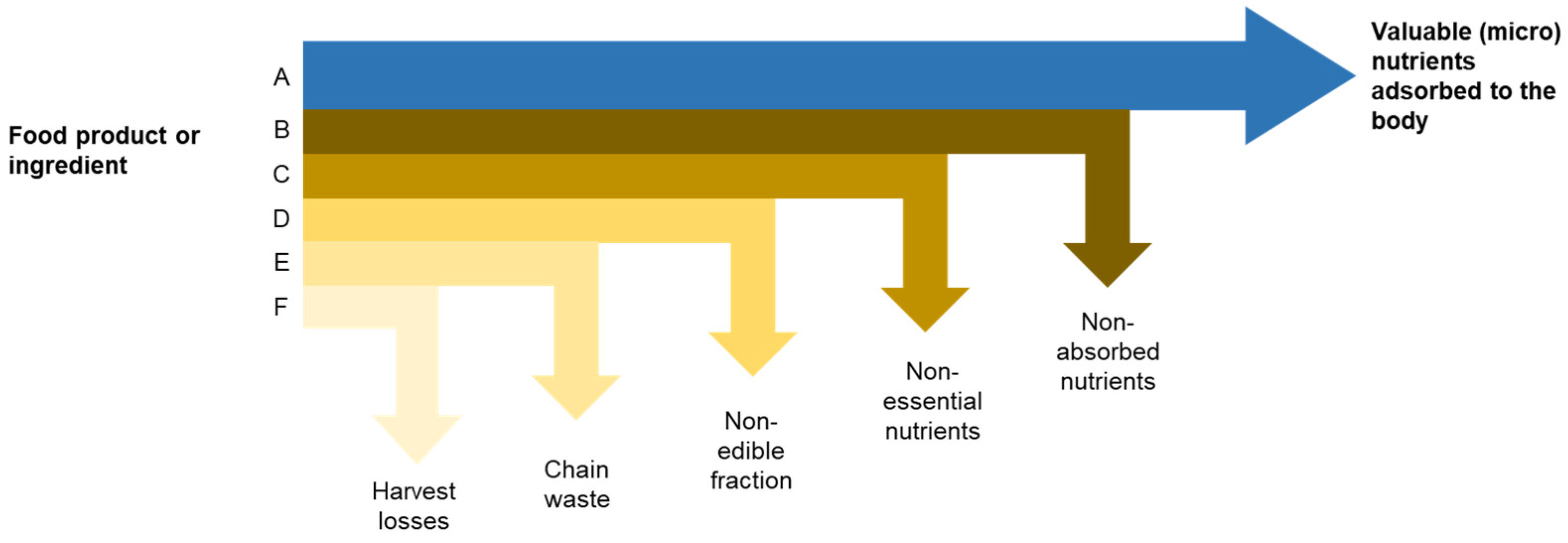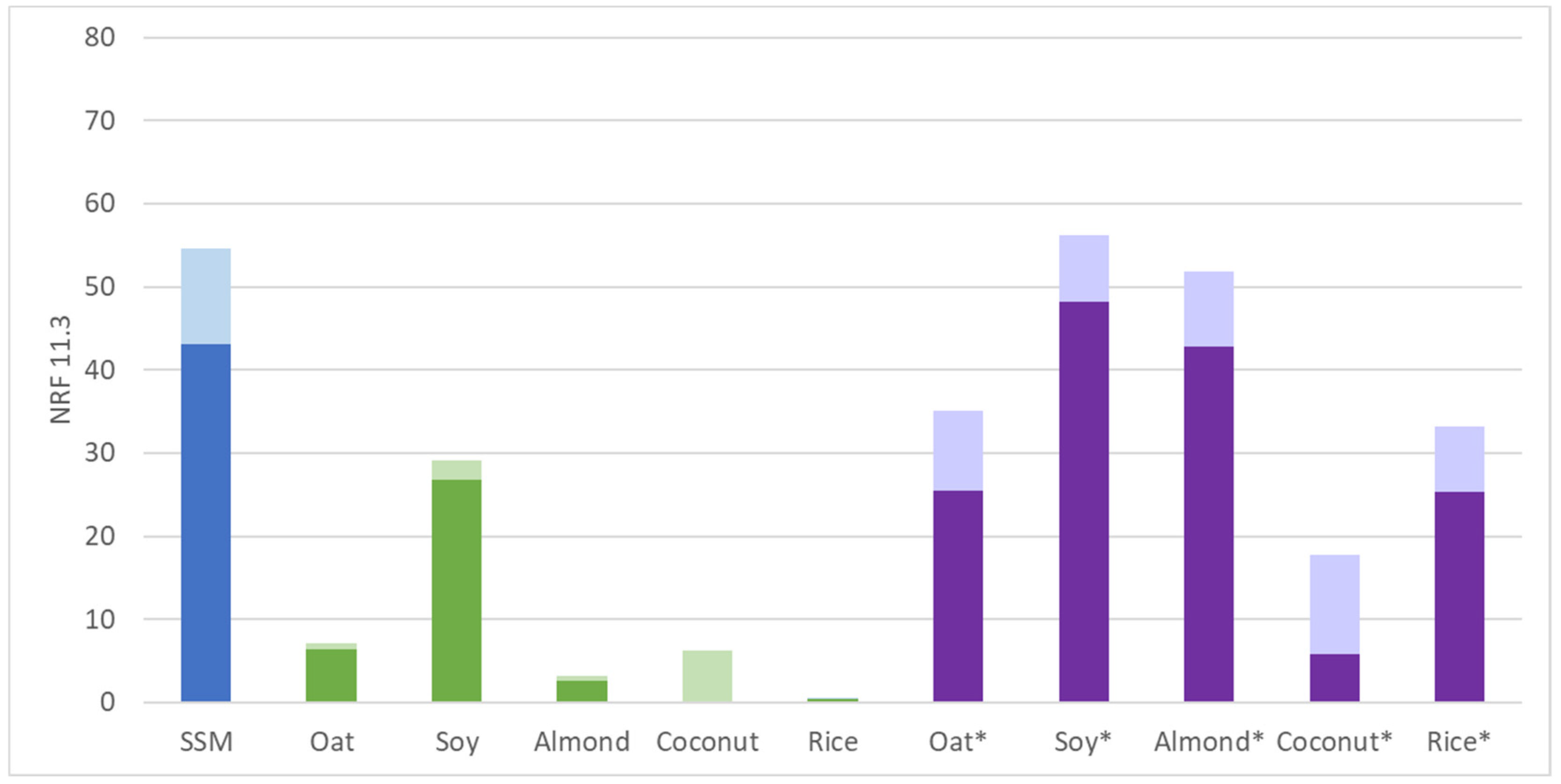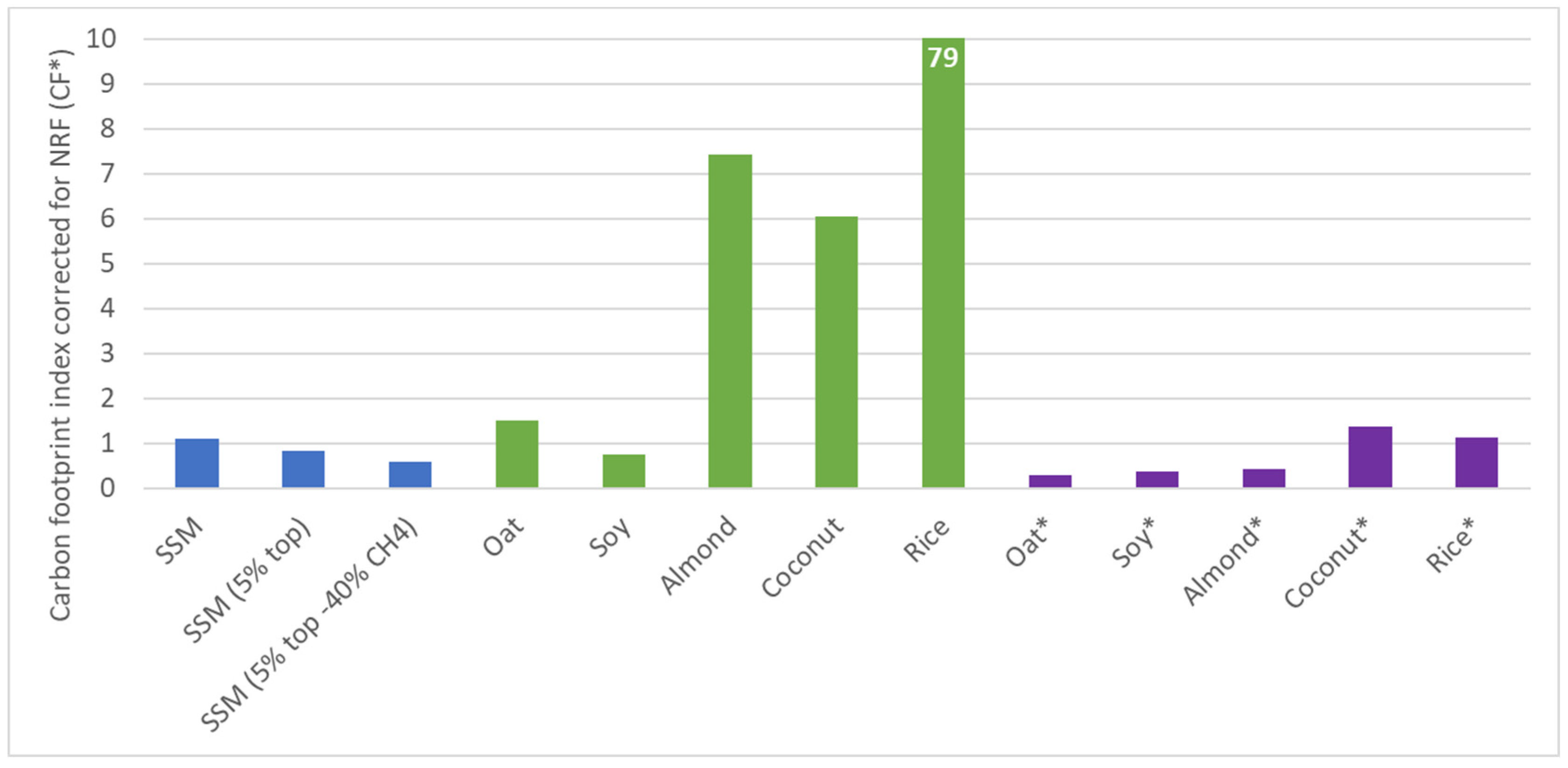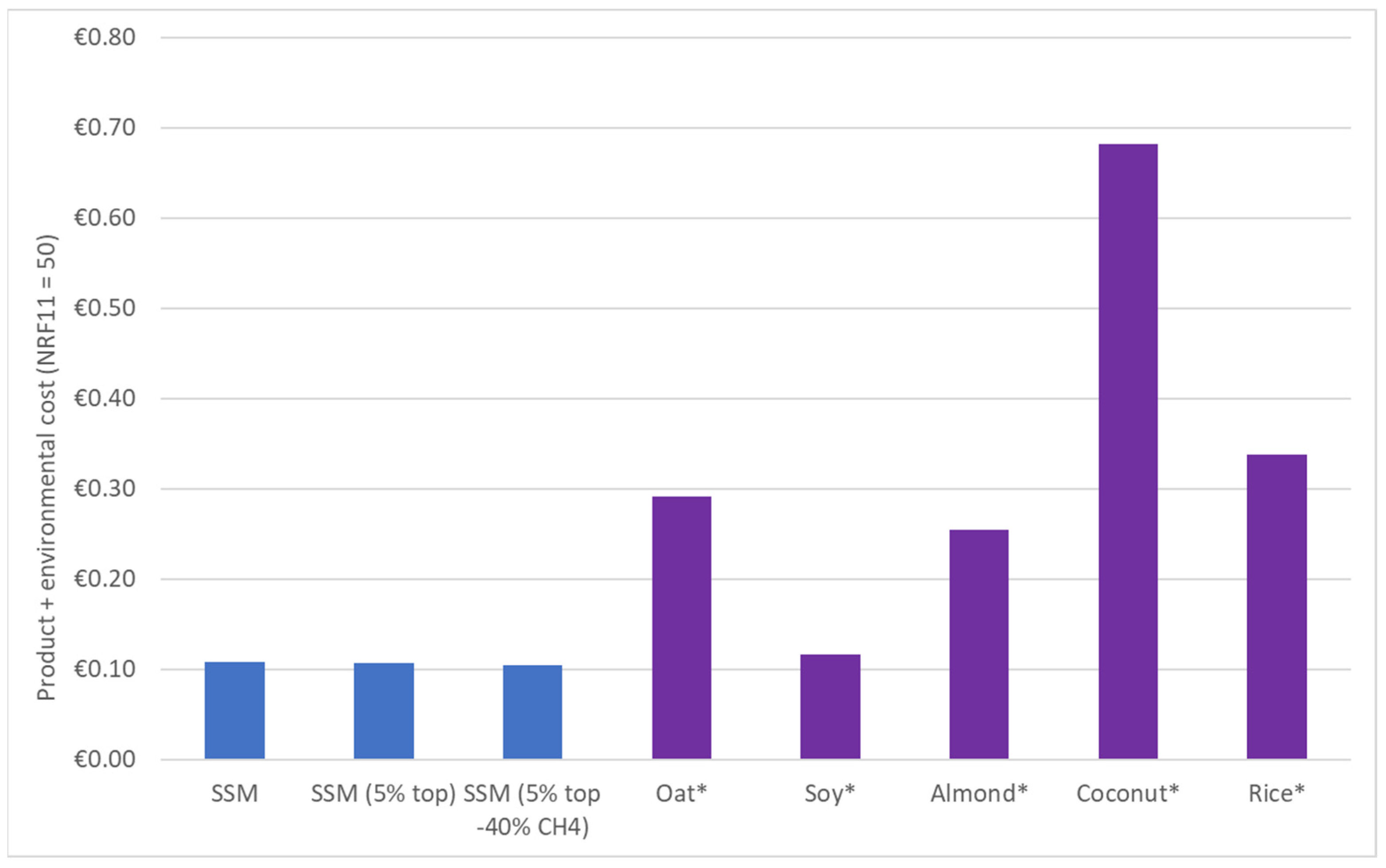Sustainability Evaluation of Plant-Based Beverages and Semi-Skimmed Milk Incorporating Nutrients, Market Prices, and Environmental Costs
Abstract
1. Introduction
2. Materials and Methods
2.1. Definition and Scope
2.2. Production Chain Approach
2.3. Incorporating Nutrients Comparing Carbon Footprints
2.3.1. Nutrients
- NRF9: protein (g), fibers (g), vitamin A, C, D (mg), Ca, Fe, Mg, K (mg)
- NRF11: NRF9 + vitamin B12 (ug), Sn (mg)
- Limited nutrients: saturated fatty acids (g), sugars (g), Na (mg)
2.3.2. Protein Quality
2.3.3. Quantitative Comparison of Footprints
2.3.4. Combining Environmental and Product Costs
2.4. Data Used
2.4.1. LCA Data
2.4.2. Nutritional Data
2.4.3. Data Processing
3. Results
3.1. Carbon Footprint
3.2. Nutrient Rich Food Scores
3.3. NRF Scores Corrected for Protein Quality
3.4. Environmental and Consumer Cost of Nutrients
4. Discussion
5. Conclusions
Author Contributions
Funding
Institutional Review Board Statement
Informed Consent Statement
Data Availability Statement
Conflicts of Interest
References
- FAO; GDP. Climate Change and the Global Dairy Cattle Sector—The Role of the Dairy Sector in a Low-Carbon Future; FAO: Rome, Italy, 2018; p. 36. [Google Scholar]
- Adewale, C.; Reganold, J.P.; Higgins, S.; Evans, R.D.; Carpenter-Boggs, L. Agricultural carbon footprint is farm specific: Case study of two organic farms. J. Clean. Prod. 2019, 229, 795–805. [Google Scholar] [CrossRef]
- Poore, J.; Nemecek, T. Reducing food’s environmental impacts through producers and consumers. Science 2018, 360, 987–992. [Google Scholar] [CrossRef]
- Persson, U.M.; Henders, S.; Cederberg, C. A method for calculating a land-use change carbon footprint (LUC-CFP) for agricultural commodities–applications to Brazilian beef and soy, Indonesian palm oil. Glob. Chang. Biol. 2014, 20, 3482–3491. [Google Scholar] [CrossRef]
- Liao, X.; Gerichhausen, M.J.; Bengoa, X.; Rigarlsford, G.; Beverloo, R.H.; Bruggeman, Y.; Rossi, V. Large-scale regionalised LCA shows that plant-based fat spreads have a lower climate, land occupation and water scarcity impact than dairy butter. Int. J. LCA 2020, 25, 1043–1058. [Google Scholar] [CrossRef]
- Clune, S.; Crossin, E.; Verghese, K. Systematic review of greenhouse gas emissions for different fresh food categories. J. Clean. Prod. 2017, 140, 766–783. [Google Scholar] [CrossRef]
- IPCC. Climate Change 2022: Impacts, Adaptation and Vulnerability. In Contribution of Working Group II to the Sixth Assessment Report of the Intergovernmental Panel on Climate Change; Pörtner, H.-O., Roberts, D.C., Tignor, M., Poloczanska, E.S., Mintenbeck, K., Alegría, A., Craig, M., Langsdorf, S., Löschke, S., Möller, V., et al., Eds.; Cambridge University Press: Cambridge, UK; New York, NY, USA, 2022; p. 3056. [Google Scholar] [CrossRef]
- Röös, E.; Garnet, T.; Watz, V.; Sjörs, C. The Role of Dairy and Plant-Based Dairy Alternatives in Sustainable Diets; SLU Future Food Reports 3, Swedish University of Agricultural Sciences, the research platform Future Food; SLU Future Food: Uppsala, Sweden, 2018. [Google Scholar]
- Schiano, A.N.; Harwood, W.S.; Gerard, P.D.; Drake, M.A. Consumer perception of the sustainability of dairy products and plant-based dairy alternatives. J. Dairy Sci. 2020, 103, 11228–11243. [Google Scholar] [CrossRef]
- Mintel Group Ltd. Milk and Non-Dairy Milk—US—October 2019. 2019. Available online: https://academic.mintel.com/display/919346/ (accessed on 19 December 2019).
- Kalyn, M.; Collard, M.D.; David, P.; McCormick, M.D. A nutritional comparison of cow’s milk and alternative milk products. Acad. Pediatr. 2020, 21, 1067–1069. [Google Scholar] [CrossRef]
- Walther, B.; Guggisberg, D.; Badertscher, R.; Egger, L.; Portmann, R.; Dubois, S.; Haldimann, M.; Kopf-Bolanz, K.; Rhyn, P.; Zoller, O.; et al. Comparison of nutritional composition between plant-based drinks and cow’s milk. Front. Nutr. 2022, 9, 988707. [Google Scholar] [CrossRef] [PubMed]
- McLaren, S.; Berardy, A.; Henderson, A.; Holden, N.; Huppertz, T.; Jolliet, O.; De Camillis, C.; Renouf, M.; Rugani, B.; Saarinen, M.; et al. Integration of Environment and Nutrition in Life Cycle Assessment of Food Items: Opportunities and Challenges; FAO: Rome, Italy, 2021. [Google Scholar] [CrossRef]
- Chalupa-Krebzdak, S.; Long, C.J.; Bohrer, B.M. Nutrient density and nutritional value of milk and plant-based milk alternatives. Int. Dairy J. 2018, 87, 84–92. [Google Scholar] [CrossRef]
- Smedman, A.; Lindmark-Mansson, H.; Drewnowski, A.; Edman, A.K.M. Nutrient density of beverages in relation to climate impact. Food Nut. Res. 2010, 54, 5170. [Google Scholar] [CrossRef] [PubMed]
- Drewnowski, A.; Rehm, C.D.; Martin, A.; Verger, E.O.; Voinnesson, M.; Imbert, P. Energy and nutrient density of foods in relation to their carbon footprint. Am. J. Clin. Nutr. 2015, 101, 184–191. [Google Scholar] [CrossRef] [PubMed]
- Van Dooren, C.; Douma, A.; Aiking, H.; Vellinga, P. Proposing a Novel Index Reflecting Both Climate Impact and Nutritional Impact of Food Products. Ecol. Econ. 2017, 131, 389–398. [Google Scholar] [CrossRef]
- Lukas, M.; Rohn, H.; Lettenmeier, M.; Liedtke, C.; Wiesen, K. The nutritional footprint—Integrated methodology using environmental and health indicators to indicate potential for absolute reduction of natural resource use in the field of food and nutrition. J. Clean. Prod. 2016, 132, 161–170. [Google Scholar] [CrossRef]
- Geburt, K.; Albrecht, E.H.; Pointke, M.; Pawelzik, E.; Gerken, M.; Traulsen, I. A comparative analysis of plant-based milk alternatives. Part 2: Environmental Impacts. Sustainability 2022, 14, 8424. [Google Scholar] [CrossRef]
- Tessari, P.; Lante, A.; Mosca, G. Essential amino acids: Master regulators of nutrition and environmental footprint? Sci. Rep. 2016, 6, 26074. [Google Scholar] [CrossRef] [PubMed]
- FAO. Global Food Losses and Food Waste—Extent, Causes and Prevention; FAO: Rome, Italy, 2011. [Google Scholar]
- RIVM, National Institute for Public Health and the Environment in the Netherlands. 2019. Available online: https://www.rivm.nl/voedsel-en-voeding/duurzaam-voedsel/database-milieubelasting-voedingsmiddelen (accessed on 10 September 2021).
- Bengoa, X.; Dubois, C.; Humbert, S. Product Environmental Footprint Category Rules for Dairy Products; European Dairy Association: Schuman, Brussels, 2018. [Google Scholar]
- Doornewaard, G.J.; Hoogeveen, M.W.; Jager, J.H.; Reijs, J.W.; Beldman, A.C.G. Sectorrapportage Duurzame Zuivelketen; Prestaties 2019 in perspectief; Report 2020-120; Wageningen Economic Research: Wageningen, The Netherlands, 2020; p. 210. ISBN 978-94-6395-681-9. [Google Scholar] [CrossRef]
- Lam, A.C.Y.; Can Karaca, A.; Tyler, R.T.; Nickerson, M.T. Pea protein isolates: Structure, extraction and functionality. Food Rev. Int. 2018, 34, 126–147. [Google Scholar] [CrossRef]
- Tanger, C.; Engel, J.; Kulozik, U. Influence of extraction conditions on the conformational alteration of pea protein extracted from pea flour. Food Hydrocoll. 2020, 107, 105949. [Google Scholar] [CrossRef]
- Möller, A.C.; van der Padt, A.; van der Goot, A.J. From raw material to mildly refined ingredient—Linking structure to composition to understand fractionation processes. J. Food Eng. 2021, 291, 110321. [Google Scholar] [CrossRef]
- Kyttä, V.; Roitto, M.; Astaptsev, A.; Saarinen, M.; Tuomisto, H.L. Review and expert survey of allocation methods used in life cycle assessment of milk and beef. Int. J. LCA 2022, 27, 191–204. [Google Scholar] [CrossRef]
- WHO; FAO; United Nations University. Protein and Amino acid Requirements in Human Nutrition; World Health Organisation technical report series 935; WHO Press: Geneva, Switzerland, 2007. [Google Scholar]
- Neumann, C.; Harris, D.M.; Rogers, L.M. Contribution of animal source foods in improving diet quality and function in children in the developing world. Nut. Res. 2002, 22, 193–220. [Google Scholar] [CrossRef]
- Ertl, P.; Knaus, W.; Zollitsch, W. An approach to including protein quality when assessing the net contribution of livestock to human food supply. Animal 2016, 10, 1883–1889. [Google Scholar] [CrossRef]
- Houx, J.H.; Wiebold, W.J.; Fritschi, F.B. Rotation and tillage affect soybean grain composition, yield, and nutrient removal. Field Crops Res. 2014, 164, 12–21. [Google Scholar] [CrossRef]
- Hulshof, T.G.; Bikker, P.; van der Poel, A.F.; Hendriks, W.H. Assessment of protein quality of soybean meal and 00-rapeseed meal toasted in the presence of lignosulfonate by amino acid digestibility in growing pigs and Maillard reaction products. J. Anim. Sci. 2016, 94, 1020–1030. [Google Scholar] [CrossRef]
- Herreman, L.; Nommensen, P.; Pennings, B.; Laus, M.C. Comprehensive overview of the quality of plant- and animal-sourced proteins based on the digestible indispensable amino acid score. Food Sci. Nutr. 2020, 8, 5379–5391. [Google Scholar] [CrossRef]
- FAO. Dietary Protein Quality Evaluation in Human Nutrition: Report of an FAO Expert Consultation; Food and Nutrition Paper 92; FAO: Rome, Italy, 2013; pp. 1–66. [Google Scholar]
- Philips, S.M. Current concepts and unresolved questions in dietary protein requirements and supplements in adults. Front. Nutr. 2017, 4, 1–10. [Google Scholar] [CrossRef]
- Adhikari, S.; Schop, M.; de Boer, I.J.M.; Huppertz, T. Protein Quality in Perspective: A Review of Protein Quality Metrics and Their Applications. Nutrients 2022, 14, 947. [Google Scholar] [CrossRef] [PubMed]
- European Commission. Available online: https://ec.europa.eu/clima/eu-action/eu-emissions-trading-system-eu-ets_en (accessed on 11 August 2022).
- Ember. Available online: https://ember-climate.org/data/data-tools/carbon-price-viewer/ (accessed on 11 August 2022).
- Singh-Povel, C.; Van Gool, M.; Gual Rojas, A.; Bragt, M.; Kleinnijenhuis, A.; Hettinga, K. Nutritional content, protein quantity, protein quality and carbon footprint of plant-based drinks and semi-skimmed milk in the Netherlands and Europe. Public Health Nutr. 2022, 25, 1416–1426. [Google Scholar] [CrossRef] [PubMed]
- FAO. Available online: https://www.fao.org/economic/the-statistics-division-ess/methodology/methodology-systems/crops-statistics-concepts-definitions-and-classifications/en/ (accessed on 14 November 2022).
- Fouts, J.Q.; Honan, M.C.; Roque, B.M.; Tricarico, J.M.; Kebreab, E. Enteric methane mitigation interventions. Transl. Anim. Sci. 2022, 6, txac041. [Google Scholar] [CrossRef] [PubMed]
- De Haas, Y.; Veerkamp, D.R.; de Jong, G.; Aldridge, M.N. Selective breeding as a mitigation tool for methane emissions from dairy cattle. Animal 2021, 15, 100294. [Google Scholar] [CrossRef] [PubMed]
- Voedingswaardetabel. Available online: https://www.voedingswaardetabel.nl (accessed on 9 August 2022).
- Oatly.com. Available online: https://www.oatly.com/nl-nl/stuff-we-make/ (accessed on 9 August 2022).
- Alpro.com. Available online: https://www.alpro.com/healthprofessional/benl/producten/drinks (accessed on 9 August 2022).
- Patil, U.; Benjakul, S. Coconut Milk and Coconut Oil: Their Manufacture Associated with Protein Functionality. J. Food Sci. 2018, 83, 2019–2027. [Google Scholar] [CrossRef] [PubMed]
- House, J.D.; Hill, K.; Neufeld, J.; Franczyk, A.; Nosworthy, M.G. Determination of the protein quality of almonds (Prunus dulcis L.) as assessed by in vitro and in vivo methodologies. Food Sci. Nutr. 2019, 7, 2932–2938. [Google Scholar] [CrossRef] [PubMed]
- Fulgoni, V.L.; Keast, D.R.; Auestad, N.; Quann, E.E. Nutrients from dairy foods are difficult to replace in diets of Americans: Food pattern modeling and an analyses of the national health and nutrition examination survey 2003-2006. Nutr. Res. 2011, 31, 759–765. [Google Scholar] [CrossRef] [PubMed]
- Miller, D.D. Calcium in the diet: Food sources, recommended intakes, and nutritional bioavailability. Adv. Food Nutr. Res. 1989, 33, 103–156. [Google Scholar] [CrossRef]
- Lambers, T.T.; Van Den Bosch, W.G.; De Jong, S. Fast and slow proteins: Modulation of the gastric behavior of whey and casein in vitro. Food Dig. 2013, 4, 1–6. [Google Scholar] [CrossRef]
- Adamaszwili, K. “Why a soy drink cannot be called milk” EU Court of Justice highlights the importance of protected dairy terms. Int. Dairy Mag. 2017, 6–7, 20–21. [Google Scholar]
- Lal, R. Feeding 11 billion on 0.5 billion hectare of area under cereal crops. Food Energy Secur. 2016, 5, 239–251. [Google Scholar] [CrossRef]
- Detzel, A.; Krüger, M.; Busch, M.; Blanco-Gutiérrez, I.; Varela, C.; Manners, R.; Bez, J.; Zannini, E. Life cycle assessment of animal-based foods and plant-based protein-rich alternatives: An environmental perspective. J. Sci. Food Agric. 2021, 102, 5098–5110. [Google Scholar] [CrossRef] [PubMed]
- Sevenster, M.; de Jong, F. A sustainable Dairy Sector: Global, Regional and Life Cycle Facts and Figures on Greenhouse-Gas Emissions; CE Delft: Delft, The Netherlands, 2008. [Google Scholar]
- Statista. Available online: https://www-statista-com.hvhl.idm.oclc.org/statistics/263926/soybean-production-in-selected-countries-since-1980/ (accessed on 29 August 2023).
- De Adelhart Toorop, R.; Yates, J.; Watkins, M.; Bernard, J.; de Groot Ruiz, A. Methodologies for true cost accounting in the food sector. Nat. Food 2021, 2, 655–663. [Google Scholar] [CrossRef] [PubMed]





| Product | Protein (g/100 g) | IAAs (mg/g Protein) | Corrected NRF Score (NRF11.3*) for Non-Fortified Products | |||||||||
|---|---|---|---|---|---|---|---|---|---|---|---|---|
| His | Ile | Leu | Lys | SAA | AAA | Thr | Trp | Val | ||||
| Semi-skimmed milk | 3.4 | 28 | 64 | 93 | 83 | 52 | 105 | 51 | 14 | 68 | 3.4 | 54.6 |
| Oat beverage | 1.0 | 21 | 34 | 69 | 23 | 36 | 77 | 28 | 10 | 38 | 0.62 (38%) | 6.5 (9%) |
| Soy beverage | 3.0 | 25 | 42 | 77 | 60 | 24 | 88 | 40 | 12 | 47 | 2.31 (23%) | 27.9 (4%) |
| Almond beverage | 0.4 | 20 | 29 | 66 | 30 | 45 | 115 | 29 | 9 | 34 | 0.28 (30%) | 3.0 (7%) |
| Coconut beverage | 0.1 | 18 | 42 | 74 | 47 | 53 | 93 | 25 | 0 | 54 | 0.08 (20%) | 4.0 (1%) |
| Rice beverage | 0.1 | 21 | 40 | 77 | 34 | 42 | 94 | 34 | 11 | 54 | 0.08 (20%) | 0.5 (7%) |
Disclaimer/Publisher’s Note: The statements, opinions and data contained in all publications are solely those of the individual author(s) and contributor(s) and not of MDPI and/or the editor(s). MDPI and/or the editor(s) disclaim responsibility for any injury to people or property resulting from any ideas, methods, instructions or products referred to in the content. |
© 2024 by the authors. Licensee MDPI, Basel, Switzerland. This article is an open access article distributed under the terms and conditions of the Creative Commons Attribution (CC BY) license (https://creativecommons.org/licenses/by/4.0/).
Share and Cite
de Jong, P.; Woudstra, F.; van Wijk, A.N. Sustainability Evaluation of Plant-Based Beverages and Semi-Skimmed Milk Incorporating Nutrients, Market Prices, and Environmental Costs. Sustainability 2024, 16, 1919. https://doi.org/10.3390/su16051919
de Jong P, Woudstra F, van Wijk AN. Sustainability Evaluation of Plant-Based Beverages and Semi-Skimmed Milk Incorporating Nutrients, Market Prices, and Environmental Costs. Sustainability. 2024; 16(5):1919. https://doi.org/10.3390/su16051919
Chicago/Turabian Stylede Jong, Peter, Franciska Woudstra, and Anne N. van Wijk. 2024. "Sustainability Evaluation of Plant-Based Beverages and Semi-Skimmed Milk Incorporating Nutrients, Market Prices, and Environmental Costs" Sustainability 16, no. 5: 1919. https://doi.org/10.3390/su16051919
APA Stylede Jong, P., Woudstra, F., & van Wijk, A. N. (2024). Sustainability Evaluation of Plant-Based Beverages and Semi-Skimmed Milk Incorporating Nutrients, Market Prices, and Environmental Costs. Sustainability, 16(5), 1919. https://doi.org/10.3390/su16051919





